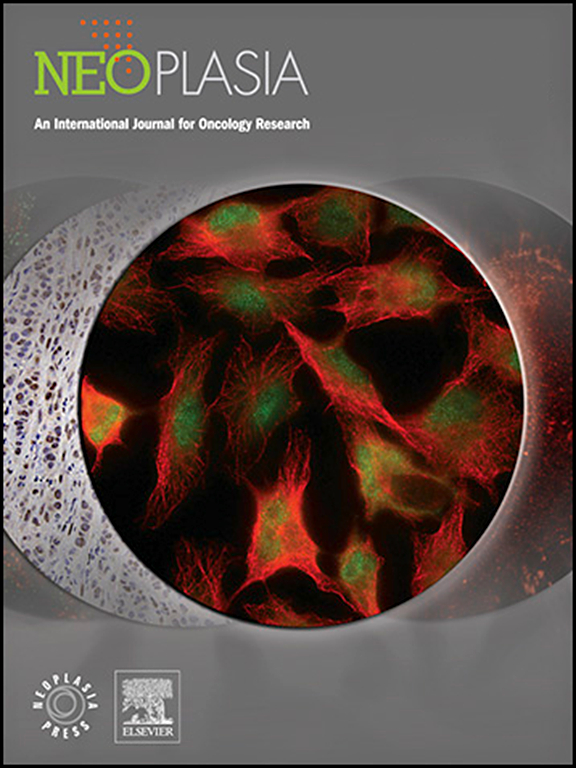SMYD2通过表观遗传学激活BMP4/SMAD1/5/8/ID3轴,增强肝癌干细胞特性并驱动索拉非尼耐药
IF 7.7
2区 医学
Q1 Biochemistry, Genetics and Molecular Biology
引用次数: 0
摘要
耐药严重阻碍索拉非尼治疗肝细胞癌(HCC)的疗效。表观遗传学在耐药性中起着重要作用。然而,SET和MYND结构域2 (SMYD2)在HCC索拉非尼耐药中的作用尚不清楚。本研究旨在阐明SMYD2在HCC索拉非尼耐药中的作用及机制。方法利用我们已经建立的索拉非尼耐药肝细胞癌(HCC)细胞系和异种移植小鼠模型,我们评估SMYD2的表达水平。为了研究SMYD2的生物学功能,我们在体外和体内进行了一系列功能测定。通过RNA测序(RNA-seq)进行转录组学分析以鉴定SMYD2的下游靶点。此外,染色质免疫沉淀(ChIP)实验被用来阐明分子机制。研究SMYD2和靶基因表达模式与HCC患者临床预后的关系。结果与亲代细胞相比,smyd2在索拉非尼耐药HCC细胞中的表达显著升高。SMYD2的敲低或过表达分别显著抑制或增强HCC的干细胞性和索拉非尼耐药性。机制上,SMYD2通过维持组蛋白3赖氨酸4 (H3K4me1)的单甲基化和组蛋白3赖氨酸36 (H3K36me2)的二甲基化修饰其启动子来促进BMP4的表达。同时,敲低或抑制BMP4可抑制索拉非尼耐药细胞的干性,抑制SMAD1/5/8 (R-SMADs)的激活,降低DNA结合抑制剂3 (ID3)基因的表达。此外,BMP4的添加或ID3的重建可以部分逆转SMYD2或BMP4的抑制所造成的影响。SMYD2/BMP4或SMYD2/ID3或SMYD2/BMP4/ID3共表达阳性的HCC患者预后最差。结论研究表明,SMYD2是激活BMP4/R-SMADs/ID3轴的重要表观遗传介质,可增强干细胞的干性和索拉非尼耐药性。因此,SMYD2可能是HCC索拉非尼耐药的潜在生物标志物和未来表观遗传治疗靶点。本文章由计算机程序翻译,如有差异,请以英文原文为准。
SMYD2 epigenetically activates BMP4/SMAD1/5/8/ID3 axis to enhance cancer stem cell properties and drive sorafenib resistance in hepatocellular carcinoma
Background
Drug resistance prominently hampers the effects of sorafenib in hepatocellular carcinoma (HCC). Epigenetics play important roles in drug resistance. However, the contributions of SET And MYND Domain Containing 2 (SMYD2) to sorafenib resistance in HCC remain unknown. This study is aimed at elucidating the role and mechanism of SMYD2 in sorafenib resistance of HCC.
Methods
Using our well-established sorafenib-resistant hepatocellular carcinoma (HCC) cell lines and xenograft mouse models, we evaluated SMYD2 expression levels. To investigate the biological functions of SMYD2, we conducted a series of functional assays in vitro and in vivo. Transcriptomic profiling via RNA sequencing (RNA-seq) was performed to identify downstream targets of SMYD2. Additionally, chromatin immunoprecipitation (ChIP) assays were employed to elucidate the molecular mechanism. Correlating SMYD2 and target gene expression patterns with clinical outcomes in HCC patients was investigated.
Results
SMYD2 expression was significantly elevated in sorafenib-resistant HCC cells compared with parental cells. Knockdown or overexpression of SMYD2 substantially inhibited or enhanced, respectively, HCC stemness and sorafenib resistance. Mechanistically, SMYD2 promoted BMP4 expression via the maintenance of mono-methylation of histone 3 lysine 4 (H3K4me1) and di-methylation of histone 3 lysine 36 (H3K36me2) modification of its promoter. Meanwhile, knockdown or inhibition of BMP4 suppressed the stemness of sorafenib-resistant cells, inhibited the activation of SMAD1/5/8 (R-SMADs), and decreased the expression of inhibitor Of DNA binding 3 (ID3) gene. Moreover, BMP4 addition or ID3 reconstruction can partly reverse the effect caused by repression of SMYD2 or BMP4. HCC patients with positive co-expression of SMYD2/BMP4 or SMYD2/ID3 or SMYD2/BMP4/ID3 exhibited the worst prognosis.
Conclusions
Our study reveals that SMYD2 is an important epigenetic mediator that activates BMP4/R-SMADs/ID3 axis, leading to enhanced stemness and sorafenib resistance. Thus, SMYD2 might represent a potential biomarker and future epigenetic therapeutic target for sorafenib resistance of HCC.
求助全文
通过发布文献求助,成功后即可免费获取论文全文。
去求助
来源期刊

Neoplasia
医学-肿瘤学
CiteScore
9.20
自引率
2.10%
发文量
82
审稿时长
26 days
期刊介绍:
Neoplasia publishes the results of novel investigations in all areas of oncology research. The title Neoplasia was chosen to convey the journal’s breadth, which encompasses the traditional disciplines of cancer research as well as emerging fields and interdisciplinary investigations. Neoplasia is interested in studies describing new molecular and genetic findings relating to the neoplastic phenotype and in laboratory and clinical studies demonstrating creative applications of advances in the basic sciences to risk assessment, prognostic indications, detection, diagnosis, and treatment. In addition to regular Research Reports, Neoplasia also publishes Reviews and Meeting Reports. Neoplasia is committed to ensuring a thorough, fair, and rapid review and publication schedule to further its mission of serving both the scientific and clinical communities by disseminating important data and ideas in cancer research.
 求助内容:
求助内容: 应助结果提醒方式:
应助结果提醒方式:


